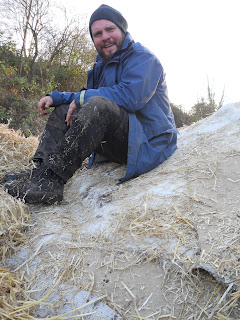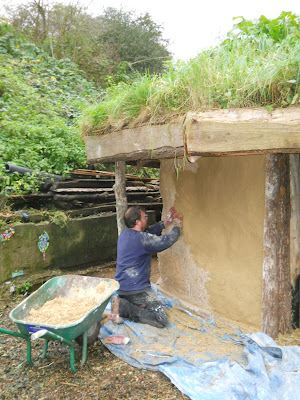A few of us farm staff are about to get on with sorting out the roundhouse at the St Werburgh's City Farm's Boiling Wells site, which has been looking decidedly sorry for itself of late. We will have help from some volunteers and young people and I'm really looking forward to getting it shipshape, so that we can really start using it properly.
I thought I'd write a bit here about what we learnt when lime rendering the construction's strawbale wall in October/November 2011.
The roundhouse was originally built by a group called 'Shift Bristol' and they put a lot of hard work into making it. They were advised initially by Tony Wrench, who has made his own roundhouse in Pembrokeshire (see
www.thatroundhouse.info). Unfortunately, Tony couldn't be there for the whole build and time was really tight for the project, so inevitably some things didn't work out as they should and the roundhouse was left not quite finished.
Since a lot of the people who helped on the build have moved on, they won't get to learn what we found out by trying to finish the jobs off. In writing this, I hope that they and other people will be able to avoid some of the mistakes we encountered and it will help make their future lime rendering projects easier!!
How the strawbale walls were constructed
The strawbale wall only makes up about a third of the total wall area of the roundhouse. The rest comprises door spaces and walls made from cordwood and bottles held together in a cob matrix, with straw stuffed into the centre of the wall between the logs or bottles.
We have had some trouble with logs shrinking as they season and working themselves loose from the cob matrix, even falling out.
The walls aren't loadbearing - the weight of the roof is taken by a wooden 'henge' which is then filled in with strawbales etc. You can see the assembled henge frame and the rafters for the reciprocal roof below:
The base of each wall section is an old railway sleeper laid flat on the ground. It's hard to tell if there is a membrane on top of this, or if the treatment already in the sleeper is being used to prevent water travelling up from the ground into the wall itself (I wasn't around when the strawbale wall was built by the group). Strawbales have been put on top of this sleeper, with hazel spars pushed in and holding them together. When we came to render the wall, it already had a thin covering of smeared clay to prevent rats nesting in it (the site is on a terracotta-type clay and is in an urban area).
Why lime render?
We wanted to use lime render as it allows a certain amount of movement within the wall and also lets it 'breathe', important with an organic building material such as straw, whilst still being waterproof. Cement render would be too brittle and eventually crack as the strawbales moved slightly under it. Clay render was too soft and could be damaged easily when dry, as well as being susceptible to damage from rain.
Lime render also looks good but needs to be handled with caution. The mix is very caustic and can make your skin very sore. It's best kept out of your eyes too! Be careful not to let it sit around on any decorative wooden areas as it will bleach them.
How we'd do it next time...
I've got to thank Rik Lander at this point for giving us his help and advice. You can see the beautiful studio that Rik constructed at
http://bristolgreenhouse.co.uk . The site also has a lot of useful links and advice on building using old tyres, hempcrete etc.
Strawbale tips
For more on how to build the strawbale wall itself, you'll need to check other sites. I can only give a few thoughts, as we took things on when the walls were already built...
First, make sure that the strawbales have the cut ends of the straw facing outwards. The long sides of the straws don't allow the render to grip to them very well, whereas the cut ends give a good key. If your wall is thinner than the length of a whole bale, you could cut the bales in half with a saw (or chainsaw) before setting them in place, but they may need some extra baling twine wrapped around each half first, to stop them falling apart. Cutting in half will also, of course, reduce their insulating properties.
When the wall is assembled, trim it to remove any overhangs and jutting bits using a chainsaw, old kitchen knife etc. but do it before you apply any clay render. It's frustrating work trying to get lime render to stick underneath an overhanging bit of bale, but not quite annoying enough to sacrifice a chainsaw blade on clay-covered walls. I don't know if the clay render made applying the lime render over it any easier, but it kept the rats out in the meantime.
The Lime render recipe that we used:
Each mix comprised:
2 buckets old render (a mix of 12 shovelfuls irregular grain sized (coarse to fine) sand, 2 shovelfuls lime putty and 4 handfuls of sawdust) I got this recipe online, but it just doesn't work. The render was far too brittle. However, we scraped it off the walls, broke it up a bit and put it back into the new mix.
You can do this with any old lime render (even after many months or even years!), put it into the new mix and it often works better than fresh-mixed stuff. If you want to revive a batch of just dried out old render to apply it, put it in the mixer with a tiny amount of water and it will be fine.
1 bag builder's sand (medium, regular-sized grains). For those in the UK, sand from Travis Perkins performed much better than that from Jewsons. Sand with very irregular grain sizes doesn't key together very well in my experience.
1 shovelful lime putty. Add a little at a time to ensure it mixes in.
1 bucketful of hydraulic lime powder (NHL 3.5). Lower numbered limes are better for rendering on straw as they are more flexible.
approx. half a bucketful straw, cut into 1 inch (2.5 cm) long pieces. Longer bits don't work well during application. The first layer of render applied needs straw in the mix to help it bind together, but the second layer onwards don't need it.
approx. 1 bucketful water. Add this in small amounts. Too much water will make the mix prone to cracking, you want enough to make it workable and no more.
***
Three of these mixes covered about 5 metres square (about 16 and a half square feet). Each layer was about half an inch (1.25 cm) thick.
Mixing the render
Get a cement mixer. Don't do it by hand unless you are a mixing machine with arms like treetrunks.
 |
| The moment we realised we were going to need a cement mixer |
Top loading drum mixers are better than front loaders, as the render tends to bind together in an unmixed lump in front loading ones and putting halfbricks in didn't help sort that out either. It's very important that the render is evenly mixed with no lumps of sand or, especially, lime putty. Remember to check that it's mixed at the back of the mixer too...
Put a big board under the mixer to protect the ground from the harsh, alkaline render.
Be careful when adding the hydraulic lime dust. Don't inhale it and keep it out of your eyes. You may like to wear a dust mask, or fix a bit of plastic sheet over the mouth of the mixer with a bungee to stop too much coming out again when mixing.
The longer the render mixes for, the 'wetter' it becomes. Don't be tempted to add too much water early on, let it mix for a while then add in small amounts.
To see if the render is ready, check that there are no lumps, take a handful and chuck it at the rim of the mixer. It should feel workable, but not wet, and it should stick to the rim.
Applying render
Don't use metal staples etc. to key the render onto the wall, as the lime will corrode them.
Make sure you are wearing old clothes and sturdy rubber gloves and wear safety specs - you don't want this stuff in your eyes! Cover any cuts as lime will interfere with healing. We kept some clean water handy, in case any eyes or skin needed to be washed. Spread old tarpaulins on the floor to protect the ground underneath and to catch falling render, which can be added into the next mix.
First, moisten the wall slightly to help the render stick. Then, take handfuls of the render and push it into the straw walls with a kind of massaging, circular action to get it right in. The first layer will have bits of straw sticking out, but they can be covered by subsequent layers or trimmed later. After about a week the next layer can be applied.
While drying, protect the render from hot direct sun and, more importantly, from frost. In hot climates, hanging hessian in front of the render and then keeping it moist may help avoid problems caused by over- rapid drying.
Finally, paint over a couple of washes of lime putty mixed half and half with water to make a 'slip'. If you don't want the finish to look dazzling white, you can add a bit of acrylic paint. I used some yellow ochre from a small tube of artist's acrylic and it gave a very nice yellowish tone to the final finish.
I hope that's useful to any readers thinking of using lime render. Ours has now been on the roundhouse wall for over a year and is still going strong. We haven't had any problems with cracking, flaking off etc. Good luck with your own projects!






















































